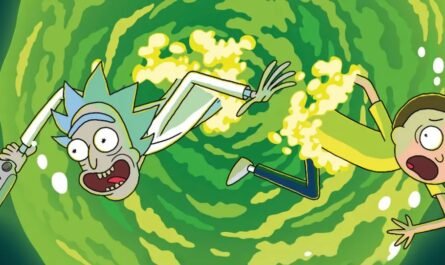Given that the anime classic was established in 1979, what is it called a “classic”? Starting from the verification of the achievements of “Galaxy Railroad 999”, the immense journey of thinking by animation critic Ryota Fujitsu begins with “past ruler” and “future ruler” in hand. A Journey to the stars.
1979 “Galaxy Express 999” blockbuster
Ever since I watched the Dolby Cinema movie “Galaxy Express 999” (directed by Rintaro), I’ve been thinking about “classic in anime” and 1979 when it was established.
“Galaxy Express 999” was released in 1979. It worked over 40 years ago. Indeed, if you look at the current teenager, it will look like old work. The content is straightforward, and it can be said that it is simple compared to the recent theatrical animation. However, “Galaxy Railroad 999” was certainly there as a work that could be called a classic.
“Galaxy Express 999” is about Tetsuro Hoshino travelling to a star where the body of a machine is free, guided by the mysterious beauty Maetel. The original manga by Leiji Matsumoto is one episode complete. The basic format was that Tetsuro met various people on the star where Galaxy Express 999 stopped and was involved in the incident, and TV animation was similar to this. On the other hand, the movie version draws even the last scene that has not been drawn in the manga yet and is released as an independent movie. The film was a huge hit and became the number one Japanese movie in distribution revenue in 1979.
Two elements that can be called classic
What we call classics here is not just old works. In my opinion, two elements coexist in a job that can be called a classic. One is the element that the thoughts and sensibilities of that era were brilliantly crystallized. The other feature showed the possibility of leading to the future generation. The ratio varies depending on the work, but I think the work that gained universality by combining these two elements is a classic.
For example, “Mobile Suit Gundam” and “Lupin III (1st series)” have a more vital element of the latter than the former. “Gundam” and “Lupin III” were very innovative in what they tried to express. However, on the other hand, looking at the actual expression, some parts have been made, some features that did not reach, and some extra detours. In that sense, the looseness like “crystallization” is weak. However, the challenging content greatly expanded the possibilities of anime. Subsequent works will continue to take on new challenges for the future, taking into account the irregularities of these pioneering works.
The crystallization of “Galaxy Railroad 999” is fantastic.
On the other hand, “999” is also one of the pioneering works, but the element of “crystallization of the sensibilities and thoughts of the times” is superior to that element. For example, if you think about how the theme song of Godiego, the hitmaker at that time, is integrated with the movie, you can see this well. Then, “what I want to express” and “expression method to convey it” are intertwined without excess or deficiency, and the work image of “youth movie in animation” is established. The splendour of its crystallization is more clearly conveyed 40 years after passing through the wind and snow of the times.
Like “999”, two animated films released in 1979 as classics with a high degree of “crystallization” ── Theatrical version “Aim for the Ace!” (Director Osamu Dezaki), “Lupin III: Castle of Cagliostro” (Director Hayao Miyazaki), “Aim for the Ace! It was produced with the same aim as “Youth Movie” as in “999”, and in the case of “Cagliostro’s Castle”, with the aim of “classical swashbuckler (by an escort hero)”. In either case, such crystallization would not have occurred if we tried to draw more complicated psychology or express a more realistic expression. It can be said that crystallization occurred because the particle size of emotions required by the times and the technology that can define them matched well.
1977 “Space Battleship Yamato” blockbuster
Why did an animated film, which could be called a classic, appear in 1979 as a whole? Here, I would like to use “999” as a sample and use “past ruler” and “future ruler”.
What I would like to pay attention to as a “ruler of the past” is that about 20 years had passed since 1979, when the postwar animation industry started in earnest in 1958 (the year when the first domestically produced colour feature animation “, The Tale of the White Serpent” was released). Is.
Over the last 20 years, the generation familiar with anime has increased. In particular, the generation born around 1960 grew older with the evolution of anime and special effects, and in 1979 became a high school student to a college student. With them at the forefront, the number of people who enjoy anime, which used to be “graduating from elementary school,” has increased even when they become junior high and high school students. It was a big hit of the movie version “Space Battleship Yamato” in 1977 that was socially visualized.
With the hit of the same work, “animation for teens” will be planned. Planning for teens meant dealing with the youth’s identity challenge and its extension of romance. In the case of “999”, that was also the aim of raising the main character’s age, Tetsuro Hoshino, from the original ten to 15 years old.
By the way, director Rin nominated Shiro Ishimori, the scriptwriter of the live-action movie “The Rendezvous” (directed by Koichi Saito), because the atmosphere between the men and women (Kenichi Hagiwara and Keiko Kishi) depicted in the same work is with Tetsuro. He said he wanted it during the Maetel. Indeed, the older woman played by Keiko Kishi in this work hides a secret, has a small number of words, and has an atmosphere familiar to Maetel.
In the main story, just before arriving at the terminal station, Tetsuro has an intense atmosphere that leads to the “promise” in a series of scenes that start from worrying that Maetel may be sinking. Maetel deliberately creates a gorgeous atmosphere and changes the story, and then Tetsuro confesses, “Why don’t we live together when we return to the earth?” It is a very raw nuance expression for the anime at that time.
“Audience change” and “creator’s career.”
On the other hand, in the 20 years since 1958, the creator’s environment has naturally changed significantly. The staff who entered the production site as newcomers at the dawn of the animation industry gained experience, and in 1979 they were at the height of their work. Furthermore, in the wake of events such as the bankruptcy of Mushi Production and the labour dispute of Toei Animation that occurred in the early 1970s, human resources in the industry became fluid. The style cultivated in each company flowed out with people and started to cause chemical reactions in various parts of the industry.
For example, Rin was born in 1941 and was 38. Initially a staff member of Toei Animation, he became a freelancer after changing jobs to Mushi Production and becoming a director there. As a freelancer, he directed several TV series on Toei Animation, an old nest, and was in charge of “Space Pirate Captain Harlock”. The evaluation of this first episode led him to be selected as the director of “999”. Rin is said to have been told by the production manager at the time how unusual it was in Toei Animation that a non-genuine director directed a feature film.
The unique point of 1979 is that the “change in the audience” and the “career of the creator” crossed well in this way. This is an element that also applies to “Mobile Suit Gundam” of the same year and “Future Boy Conan” (Director Hayao Miyazaki) broadcast the previous year.
Trial and error to acquire the “norm” of the movie
What about the “future ruler”? Twenty years after 1979, it is 1999. Looking back from there, we can see that 1979 was the starting point for the attempt to “make a movie with anime.”
The definition of what makes a movie is different for the creator. Some creators are not particular about the genre of film. However, in any case, some “norm” is still needed to control the length of 90 to 120 minutes. It is impossible to maximize the pleasure (in a broad sense) when watching a video for a long time due to sagging or straying just by developing an extended episode. To maximize enjoyment, the creator needs to assemble the work by making full use of omission and emphasis based on his own “norm”.
For example, the early feature films of Toei Animation may be thought of as trial and error in an attempt to acquire that “norm.” Also, Mushi Production’s “Animerama” trilogy (“One Thousand and One Nights”, “Cleopatra”, “Belladonna of Sadness”) does not seem to have a clear norm, except for “Belladonna”.
In other words, when trying to make a movie with animation in 1979, the animated film that could be directly helpful is “Bella Donna” in 1973, “Lupin III (VS Reproduction Human)” in 1978, and “Farewell Space Battleship Yamato Ai no”. It was about “warriors”.
Director Rin recalls making “999” as a feature film as follows.
I don’t know how to make a feature film within myself. I wondered what to do, and if I could do a feature film, I thought I had to do it like a TV. The feeling of TV is not the number of drawings but the speedy feeling inside me. “PLUS MADHOUSE 4 Rintaro” Studio Male / Kinema Junpo
Elsewhere, Rin also said that he had in mind the styles of French and Italian films that he had been watching since he was a junior high school student. In other words, Rin was searching for the “norm” to make his movie while making it.
I think that Leiji Matsumoto’s work has some sentimentalism. If the word sentimentalism is different, it’s ridiculous. Aesthetics of ridicule. (Omitted) I don’t hate that either. However, I’m not courageous enough to take it out. I think, “It’s not good to put out that kind of thing.” However, about “999”, while I was drawing the storyboard, the content became bloody, and I became a centimetre. Same as above
When you watch the main story, this “speedy narrative” and the emotion-centred scene where sentimentalism comes to the fore are nicely combined with changing the movie’s pace. For example, the series of scenes in which Tetsuro, at the trader’s turning point, walks around the city, enters the bar and listens to the song of the crown depicts Tetsuro walking around in the music scene. It is comical when the music is over, like a punctuation mark. The barking of a cat, the set where you can listen to a song quietly in a bar, and the change in pace are lovely.
Director Rin’s production will come to the fore in the sequel “Goodbye Galaxy Express 999-Andromeda Terminal Station-” The display will lead the movie. This director Rin’s narrative has been further refined to release his masterpieces such as “The Dagger of Kamui” (1985) and “X” (1996).
Hayao Miyazaki, Osamu Dezaki, Mamoru Oshii … Continue to the world.
Director Dezaki released “SPACE ADVENTURE Cobra” (1982) and “Golgo 13” (1983) and feature films, followed by the “Theatrical Version Tottoko Hamtaro” series, and in 2007 directed “Theatrical Version CLANNAD”. There is. What you should not forget here is “Aim for the Ace! Oshii Mamoru, who obtained his own “norm” by analyzing “Urusei Yatsura 2 Beautiful Dreamer” (1984), established his world. Oshii announced “GHOST IN THE SHELL” in 1995 and became known worldwide. These events happened in the 20 years of the “Future Ruler”.
If you try to guess the “ruler of the future”, you can see that in 1979, the self-consciousness of facing animated films began in earnest.
It is considering the history of anime after that, such as the challenges and chaos of the 1980s and the establishment of high-precision screen making since the mid-1990s, the works of 1979 and some of the results of the 1970s that preceded it are modern. It can be called an “anime classic” in terms of relationships.
(Fujitsu Ryota) An anime critic. After working as a newspaper reporter and editor of a weekly magazine, he began writing anime-related articles in 2000. “Anime Gate V” (“Anime! Anime!”), “Conditions for the main character” (“Anime Hack”), “Acchi (live) and Kochi (animation)” (“BANGER !!!”), “Anime In addition to serialization such as “To Game ≒” (“Gamer”), he has also worked on many magazines, Blu-ray booklets, and pamphlets. His major books include “My Voice Actors Talked by 13 Professionals” (Kawade Shobo Shinsha) and “Why We Watch Anime” (Film Art).











